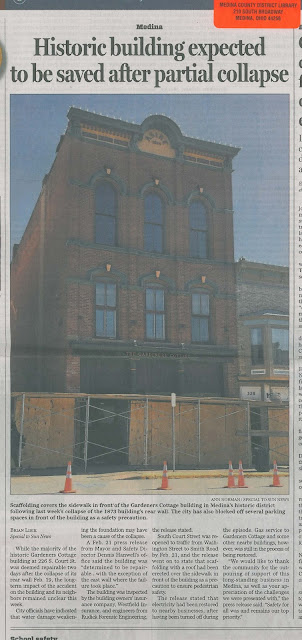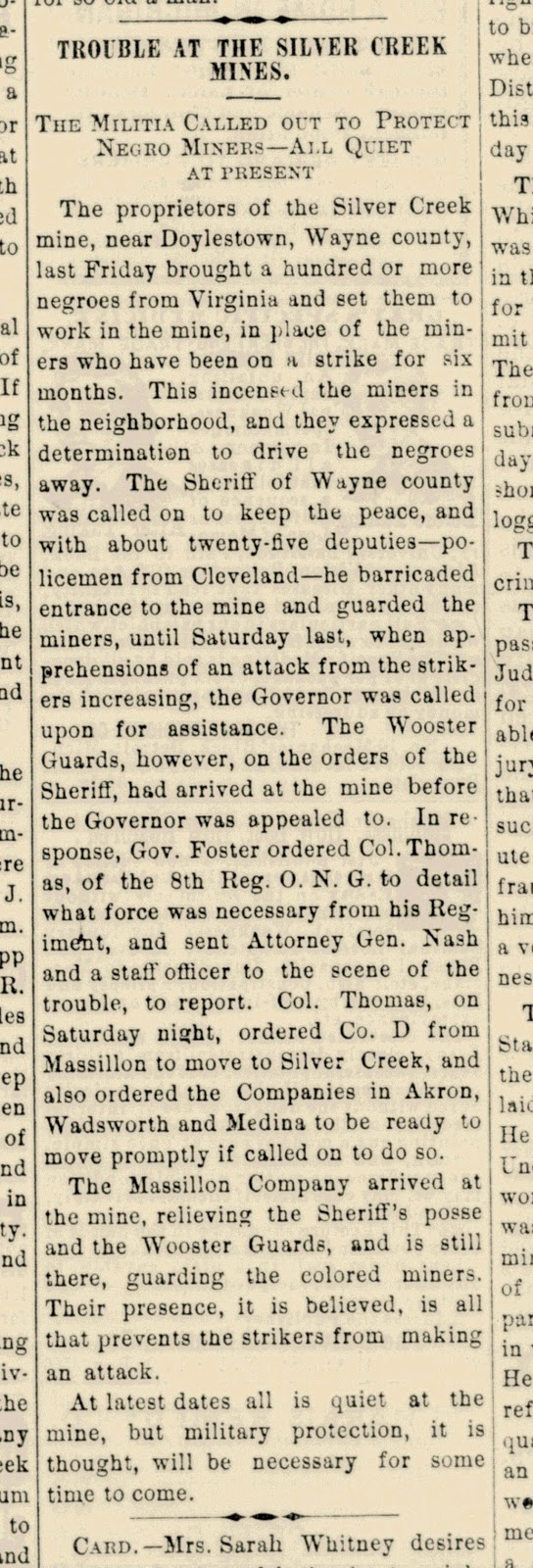The Medina Library has just purchased several Wadsworth newspapers on microfilm.
 |
| Masthead from the Wadsworth Enterprise |
What?!? You're not thrilled!
Wait. You will be.
First, how can you not love using newspapers for historical and genealogical research?
In newspapers you can find information on your ancestors that you cannot find anywhere else. Sure, you can find birth, marriage and death notices. But you also find information about your ancestor's real estate sales, businesses (and the ads they put in the paper), out of town visitors, vacation plans, engagements and illnesses.
 |
| Portage Sentinel 24 February 1847, page 4. William Tagg followed his father, James, into the painting and glazing business. |
 Not too long ago, I found a notice where one of my relatives hosted the birthday party for his mother-in-law. It included a list of all the guests. A whole list of people that can now be added to my research plans.
Not too long ago, I found a notice where one of my relatives hosted the birthday party for his mother-in-law. It included a list of all the guests. A whole list of people that can now be added to my research plans.And when I was researching my 3X great-grandfather, James Tagg, I found a notice of his attendance at a GAR reunion. It told how the gathering was entertained by his stories from his Civil War Service. Apparently, he was a storyteller. Who knew?
 |
| Excerpt from a larger article on the Reunion of the 91st O.V.I. Gallipolis Tribune 1 August 1894, page 3. |
 |
| Cleveland Plain Dealer 6 November 1929, page 7. Clara was running for a seat on the Cleveland Board of Education. It was a position she held for the rest of her life. |
Now, in Medina County, the type of news reported in the papers changed over time. The early papers, 1830-1866, mostly consisted of national and political news. Many of these early papers affiliated with a particular political party and their articles reflected a strong bias. But when you do find information on a ancestor or local resident, you cherish it even more.
Some, like the one below, can fill in the gaps for a period when vital records are scarce or nonexistent.
Around 1870, more articles on local events and people start creeping into the paper. This trend continued until about 1960. Papers from the 30s, 40s and 50s, are FULL of social events that list everyone who attended and often describe the food served and the clothes worn. These details help give us insight into our ancestor's lives - the best of reasons to get excited about newspapers!
And the Medina County District Library has never owned any of the Wadsworth newspapers on microfilm, until now.
Here is the list:
Medina Watch Tower – 1 reel
Sep 12, 1838-Apr 14, 1841
June 2 & 9, 1841
Aug 4, 1841-Mar 2, 1842
Wadsworth Enterprise – 3 reels
May 4, 1866 to April 25, 1877
Wadsworth News Banner – 26 reels
Feb 3, 1910- Dec 29, 1955
Wadsworth News – 6 reels
Oct 30, 1920-Oct 6, 1932
Feb 23-Sep 2828, 1933
Nov 2, 1933 –June 29, 1944
Now, besides the fact that Wadsworth is one of three cities within Medina County, what can we get out of these films?
First, the Wadsworth Library has the obituaries in the Wadsworth newspapers indexed as part of the Ohio Obituary Project on the Rutherford B. Hayes Presidential Library and Museum website: http://www.rbhayes.org/ Access to more obituaries? That is always a good thing!
Next, imagine how my blog on the Wadsworth Coal Mines could be impacted by having access to these Wadsworth newspapers. The post would probably contain a lot more detail than I was able to glean from The Gazette.
AND...
The 1876 editions of the Medina Gazette have always been MIA (Missing In Action). This is critical for two reasons that come immediately to mind.
- 1876 was the American Bicentennial. As Medina is celebrating its Bicentennial, wouldn't you like to know how the county celebrated the first U.S. Centennial in 1876? Me too!
- 1876 was the year the H.G. Blake died and for years local historians (including myself) have searched for his obituary. If you want to know who Blake was, read this POST.
The Wadsworth Enterprise has its 1876 editions:
 |
| The Wadsworth Enterprise 19 April 1876, page 4. |
NOW are you excited? Me too!























